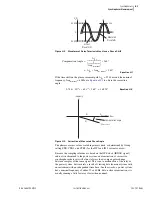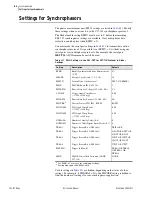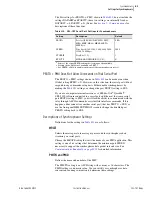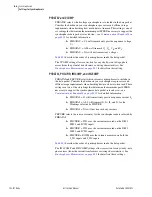
I.3
Date Code 20081022
Instruction Manual
SEL-787 Relay
M
IRRORED
B
ITS
Communications
Operation
shows an example of the values of the M
IRRORED
B
ITS
for a
RXDFLT setting of 10100111.
Individual pickup and dropout security counters supervise the movement of
each received data bit into the corresponding RMB
n
element. You can set each
pickup/dropout security counter from 1 to 8. A setting of 1 causes a security
counter to pass every occurrence, while a setting of 8 causes a counter to wait
for eight consecutive occurrences in the received data before updating the data
bits. The pickup and dropout security count settings are separate. Control the
security count settings with the settings RMB
n
PU and RMB
n
DO.
A pickup/dropout security counter operates identically to a pickup/dropout
timer, except that the counter uses units of counted received messages instead
of time. Select a setting for the security counter in accordance with the
transmission rate (see
). For example, when transmitting at 2400
baud, a security counter set to 2 counts delays a bit by about 30 ms. However,
when operating at 9600 baud, a setting of 2 counts delays a bit by about
8.5 ms.
You must consider the impact of the security counter settings in the receiving
relay to determine the channel timing performance, particularly when two
relays of different processing rates are communicating via M
IRRORED
B
ITS
,
such as an SEL-321 and an SEL-787. The SEL-321 processes power system
information each 1/8 power system cycle, but, when transmitting at 19200
baud, the SEL-787 processes M
IRRORED
B
ITS
messages at 4.15 ms at 60 Hz
(4 times per power system cycle at 60 Hz). Although the SEL-321 processes
power system information each 1/8 power system cycle, the relay processes
the M
IRRORED
B
ITS
pickup/dropout security counters as M
IRRORED
B
ITS
messages are received. Because the SEL-787 transmits messages at
approximately 1/4-cycle processing interval (9600 baud and above, see
), a counter set to two in the SEL-321 delays a received bit by another
approximately 1/2 cycle. However, a security counter in the SEL-787 with a
setting of two delays a received bit from the SEL-321 by 1/4 cycle, because
the SEL-787 is receiving new M
IRRORED
B
ITS
messages each 1/8 cycle from
the SEL-321.
Channel
Synchronization
When an SEL-787 detects a communications error, it deasserts ROKA or
ROKB. If an SEL-787 detects two consecutive communications errors, it
transmits an attention message, which includes the TXID setting. The relay
transmits an attention message until it receives an attention message that
includes a match to the TXID setting value. If the attention message is
successful, the relay has properly synchronized and data transmission
resumes. If the attention message is not successful, the relay repeats the
attention message until it is successful.
Table I.2
Positions of the M
IRRORED
B
ITS
Bit/
Row
7
6
5
4
3
2
1
0
88
RMB8A
RMB7A
RMB6A
RMB5A
RMB4A
RMB3A
RMB2A
RMB1A
90
RMB8B
RMB7B
RMB6B
RMB5B
RMB4B
RMB3B
RMB2B
RMB1B
Table I.3
M
IRRORED
B
ITS
Values for a RXDFLT Setting of 10100111
Bit/
Row
7
6
5
4
3
2
1
0
88
1
0
1
0
0
1
1
1
Summary of Contents for SEL-787
Page 1: ...20081022 SEL 787 Transformer Protection Relay Instruction Manual PM787 01 NB ...
Page 6: ...This page intentionally left blank ...
Page 12: ...This page intentionally left blank ...
Page 18: ...This page intentionally left blank ...
Page 78: ...This page intentionally left blank ...
Page 206: ...This page intentionally left blank ...
Page 280: ...This page intentionally left blank ...
Page 334: ...This page intentionally left blank ...
Page 376: ...This page intentionally left blank ...
Page 388: ...This page intentionally left blank ...
Page 474: ...This page intentionally left blank ...
Page 508: ...This page intentionally left blank ...
















































